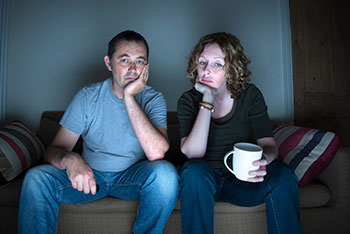 Sept. 16, 2015 – If it seems that the only people wanting to marry these days are gay and lesbian couples, you may be right. The number of Americans choosing to cohabitate instead of marry is at an all-time high for every age group.1 Almost three out of four women will have cohabitated with a partner by the age of 30.2 Millennials, people born between 1981–2000, reported a 45 percent increase in cohabitation in the past 25 years. Twenty-five percent of these millennials intend to remain unmarried forever.3 Why the lack of interest in marriage? These young adults report that they haven’t found the right person, they are not financially stable enough to marry, and simply have no desire to settle down.4
Sept. 16, 2015 – If it seems that the only people wanting to marry these days are gay and lesbian couples, you may be right. The number of Americans choosing to cohabitate instead of marry is at an all-time high for every age group.1 Almost three out of four women will have cohabitated with a partner by the age of 30.2 Millennials, people born between 1981–2000, reported a 45 percent increase in cohabitation in the past 25 years. Twenty-five percent of these millennials intend to remain unmarried forever.3 Why the lack of interest in marriage? These young adults report that they haven’t found the right person, they are not financially stable enough to marry, and simply have no desire to settle down.4
The millennials are not the only ones embracing cohabitation. The Generation X group, people born between 1965-1980, has experienced the biggest increase of cohabitation with an increase of 214 percent of women between the ages of 40-44 who now live with an unmarried partner.5 And Baby Boomers, people born between 1946-1964, have doubled their numbers of people who live with a partner outside of marriage with 1.2 million a decade ago to 2.75 million in 2010.6 This is remarkable because this is the same generation that once shunned cohabitation as immoral.
What is the reason for this shift among older adults? According to a study in the Journal of Marriage and Family, older Americans are electing cohabitation because of the financial benefits of living together while not giving up Social Security benefits from a deceased spouse, not becoming liable for a partner’s medical debts, the lack of desire or need for a large wedding at this stage in their lives, and, for women, the attitude that they have “taken care of one man, and are not interested in taking care of another man.”7
If there is one difference between the cohabitation of younger adults with their older counterparts, it is the stability of the relationships. For older adults, the cohabitation seems to be a long-term alternative to marriage whereas with younger adults, the cohabitation is either seen as a precursor to marriage or a “test run” of the relationship.8 In most instances, for the younger couples, the “test run” fails and the relationship ends. According to one study, cohabitating relationships frequently end within five years.9 Only about 50 percent of people who cohabitate report being “very satisfied” in their relationship versus 70 percent for married spouses.10
This dramatic rise in unmarried couples, and the high rate of dissatisfaction within these relationships, will have an impact on many areas of the law but most prominently on family law. Depending on the circumstances of the relationships, the law seems to be moving towards a recognition of “de facto marriages” when the cohabitation ends. Wisconsin does not recognize common law marriage, but much of the language in the cohabitation cases seem to mimic considerations you would find in a divorce.
Legal or Equitable Rights of Cohabitating Partners
The seminal case in Wisconsin addressing the legal or equitable rights of partners when their cohabitation ends is Watts v. Watts.11 In Watts, the couple had been together for 12 years, had two children together, and held themselves out in many respects as husband and wife, but never married. When the relationship ended, Sue Ann Watts sought a share of the property accumulated during the relationship. The Wisconsin Supreme Court held that the property division statute under the divorce statutes was not available to her, but she did have a viable claim for expressed or implied contract, partition, constructive trust, and unjust enrichment.12
 Christopher S. Krimmer, U.W. 1997, is a partner at Balisle & Roberson S.C. in Madison, practicing exclusively in family law. He’s also an adjunct professor at Marquette Law School, and is admitted into the Academy of Matrimonial Lawyers. Reach him by phone at (608) 259-8702, or by email.
Christopher S. Krimmer, U.W. 1997, is a partner at Balisle & Roberson S.C. in Madison, practicing exclusively in family law. He’s also an adjunct professor at Marquette Law School, and is admitted into the Academy of Matrimonial Lawyers. Reach him by phone at (608) 259-8702, or by email.
Over time, it is the equitable claim of unjust enrichment that has become the “cohabitated divorce action.” In this context, the party must establish three elements: 1) an accumulation of assets, 2) acquired through the efforts of the claimant and the other party, and 3) the assets are retained by the other party in an unreasonable amount.13 If established, in civil court with the right to a jury, the claimant then is entitled to an equitable division of the assets – not a presumed equal division that a spouse would have in a divorce action.14
It is important to note that the cohabitation alone does not give rise to a claim for unjust enrichment. The claimant must establish that there was a “joint enterprise” during the relationship in which both parties made financial contributions or services to the joint undertaking of accumulating assets together.15 This may or may not include joint financial accounts, joint tenancy in real estate, joint sharing of expenses, and even housekeeping and child rearing duties that allowed the other partner to acquire the property during the relationship.
Advice to Protect Cohabitating Partners May Also Support an Unjust Enrichment Claim
The very same things that an attorney may advise a couple to obtain to protect their relationship as an unmarried couple may, in turn, be the evidence necessary to establish an unjust enrichment claim if that relationship ends. The more evidence, documents, or conduct indicating a “joint undertaking” or “joint enterprise” of the two unmarried partners, the more likely the court will find that the assets were accumulated under the auspice of an equal sharing arrangement when the relationship ends.
These actions or advice to protect the cohabitating couple, which could be used as a basis for an equitable division, include:
If they are a same-sex couple, they could register with the State Domestic Partnership Registry. The registry grants the couple approximately 40 rights and benefits associated with marriage, but without any of the obligations of marriage such as marital property law, a duty of support, or divorce. The registry was enacted to provide some protection to gay and lesbian couples when marriage was denied to them. This is the reason why the registry is only available to same-sex couples.16
A comprehensive estate plan that includes wills, a joint trust, and power of attorneys designating the other partner as the partner’s agent.17
Many couples wish to avoid formal probate so they may be advised to hold joint accounts with beneficiary designations, payable on death designations, and real estate held either as “domestic partners” or “joint tenants with right of survivorship.”
Many private employers offer employees a health insurance plan that allows a person to add his or her unmarried partner on the employee’s health insurance. The health insurance plan’s definition of “domestic partner” is generally separate and distinct from any government-sanctioned definition of domestic partner, and instead, is based on documentation of a joint residence, joint bank accounts, and estate planning documents.
In short, the more steps the couple take to protect their relationship as an unmarried couple, the more they should realize that many of those same efforts could be used to establish a claim for unjust enrichment or implied contract when that relationship ends. This is not necessarily a bad or good thing, but something that many couples may not realize when living together. They may believe that they are avoiding the possibility of a “divorce” or future litigation regarding the property accrued during the relationship by not marrying, but the reality is that there are legal and equitable claims available to the partner who believes the property was not divided equitably at the dissolution of their relationship.
A person in a joint household with an unmarried partner is even less likely to seek legal advice than a person who is about to marry. A person who is about to marry is generally knowledgeable about Wisconsin’s marital property law and the legal presumptions in a divorce. They are also more likely to know about the availability of a Marital Property Agreement. The same is not likely true for the person living with his or her partner and knowing of the need or option to enter into a Cohabitation Agreement that also identifies and outlines the rights of both partners if the relationship ends. They may be naively believing that title controls ownership during the cohabitation even when both partners are making contributions toward those assets and property.
Conclusion
As more people decide to eschew marriage, lawyers will need to identify the rights and responsibilities of unmarried partners during the relationship and if the relationship ends. Our state jurisprudence has already provided the legal framework for these couples, but this is certainly one area of the law that will develop over time and require the skill, knowledge, and creativity of both the bar and bench in addressing the equities involved in cohabitation cases.
Endnotes
1 National Center of Health Statistics, Trends in Premarital Cohabitation (citing CDC report www.cdc.gov/nchs/data/nhsr/nhsr064.pdf).
2 Wendy D. Manning & Bart Stykes, Twenty-five Years of Change in Cohabitation in the U.S., 1987-2013. National Center for Family & Marriage Research, Family Profiles, Vol. 15-01.
3 Belinda Luscombe, Why 25% of Millennials Will Never Get Married, Time, Sept. 24, 2014.
4 Id.
5 Supra note 2.
6 Randy Dotinga, More Baby Boomers Opting to Cohabit, Not Marry, Health Day, Aug. 31, 2012 (citing a study by the National Center for Family and Marriage Research at Bowling Green State University in Ohio).
7 Id.
8 Id.
9 Casey E. Copen, et al., First Premarital Cohabitation in the United States: 2006–2010 National Survey of Family Growth, National Health Statistics Reports, U.S. Department of Health and Human services, No. 64, April 4, 2013.
10 Supra note 6.
11 Watts v. Watts, 137 Wis. 2d 506, 405 N.W.2d 303 (1987).
12 Id. at 538.
13 Waage v. Borer, 188 Wis. 2d 324, 330, 525 N.W.2d 96 (Ct. App. 1994).
14 Ulrich v. Zemke, 2002 WI App 246, ¶ 12; 258 Wis. 2d 180, 654 N.W.2d 458.
15 Id.
16 The State Domestic Partnership Registry should not be confused with the State EmployeeDomestic Partnership Registry which allows both same-sex and opposite-sex couples who work for the state and its subdivisions certain employment benefits such as survivor benefits and health insurance.
17 See e.g., Leonard v. Lynn, 2010 WI App 145, 330 Wis. 2d 97, 791 N.W.2d 405 (Court relied, in part, on the defendant’s will in determining credibility of defendant’s testimony of whether a joint enterprise existed between him and his unmarried partner.)
